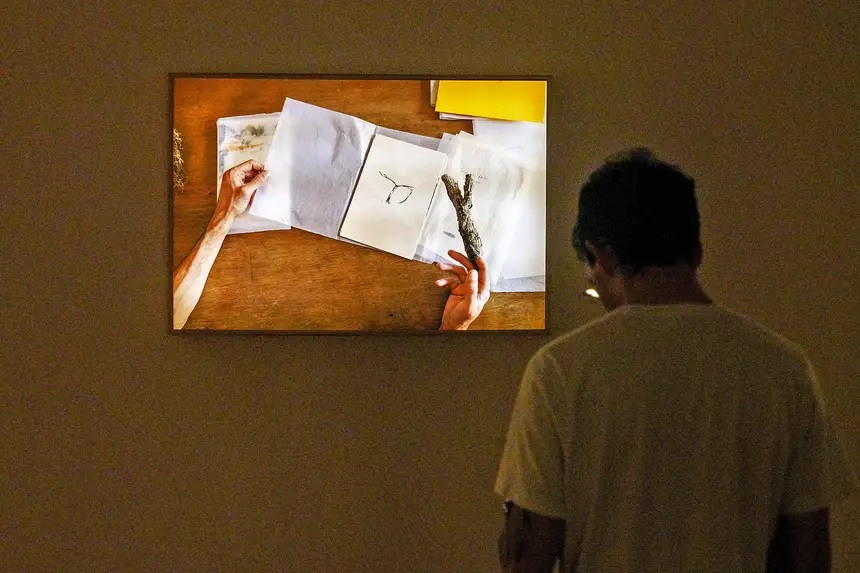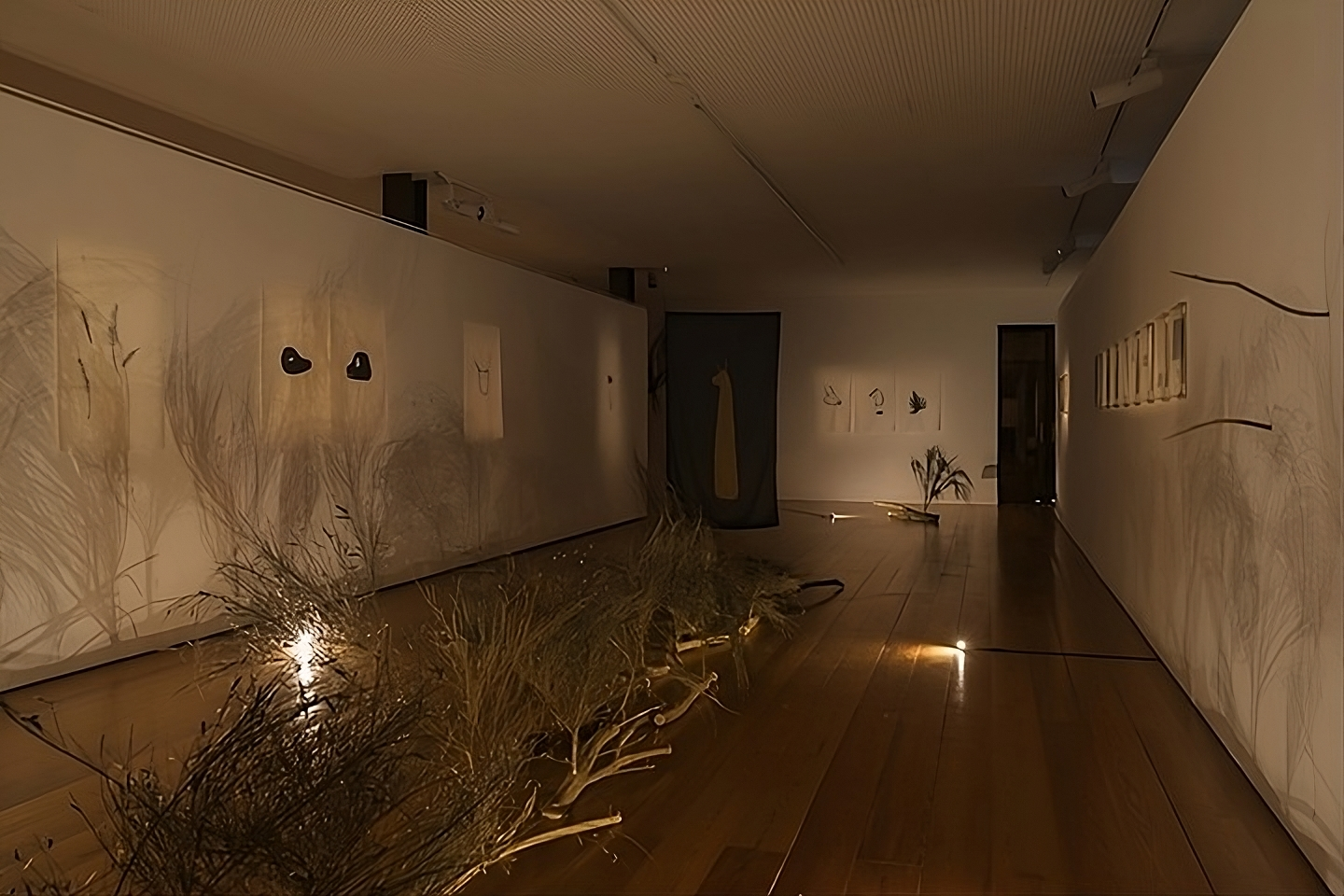AUTHOR: IVO MARTINS
EDITION: (Catalogue) Centro Cultural Vila Flor DATE: July 2023
The radiant galaxy of artistic creation harbours an uncontrollable, unmanageable dark matter, a blend of impulses with which we remain entirely unfamiliar. For this reason, our craft of invention can only lightly probe this obscure material, unable to grasp its forms and or even comprehend its motions. Art is a construction, and as such it is relative in the sense that it is tied to contingency, volatility, chance—the specific circumstances in which it occurs and the manifold shifts in direction with which we are entwined. Creation thus emerges from a profound critical imbalance between the interior and the exterior, a result of existential crises whose factors are difficult to control; in this sense, “crisis” represents a disconnect embodied by “criticism,” with both terms considerably exhausted by their abundant usage in our daily discourse.
In this world that is also classified as ahistorical, nothing can be categorically imposed and contradictions are inherent; when we feel that we cannot control these contradictions, we find solace and point to crisis. However, if we look at the past, we realise that criticism and crisis have always been woven into the fabric of human narratives, with the terms through which they have been expressed determining their use as warnings. Between the terms "crisis" and "criticism," our narrative power becomes blurred, dissolved into circular elucidations that say and resolve nothing—we speak of crisis primarily to avoid silence, insofar as we have exhausted our explanatory resources and silence has become unbearable. It therefore seems evident that we are currently surrounded by too many discourses and an excess of words. Under the cloak of erudite chatter that accuses our current society of fostering crises in culture, most specifically in the humanities, crisis is imitated and repeated, like the simulacrum of a truth rendered relative and banal, with all of its clichés.
Much like ancient forms of music and dance, crisis has tamed the repetitive noises whose unchanging harmonic and rhythmic texture reflects our inability to take action, almost as if some tribe's dialect had been drowned out by the grammatical buzz of chain-information-rendered-fake-news. In this sense, we exist in a system where it feels as though the distant voices of our ancestors have simply been shelved in the stagnant tomb of museums and online archives—perhaps we are living in a rather strange time when "crisis" and "criticism" no longer mean anything to us. Or maybe we are demanding more from these words than they can explain, more than they are now capable of delivering. With this backdrop, crisis and criticism become opportunistic resources, make-shift syntheses we lean on in order to navigate the drift of our daily rhetorics, which move like pretentious viruses within multitudinous theatricalisations of emptiness.
Today, we are constantly bombarded by tangled narratives: some optimistic, others pessimistic; some sorrowful, others joyful—poles of positivity and negativity, rationality and irrationality that do little to combat the rampant use of the term/cause rooted in the concept of crisis. We allow the big-small discourse of our crises to persist because it is a straightforward, easily justifiable solution. Through crisis, we create mechanisms to deceive ourselves and one another, leading to all manner of misunderstandings that foster erratic stances. Any ideas that might trigger true judgements of value eventually prove distorted and detached from the real on account of critical standpoints that contribute to the confusion within which the crisis has engulfed us. With crisis comes an ultimate explanation, often grounded in the banality of criticism and vice versa; in this sense, crisis and criticism are more reflections of our personal, inner, and collective issues than external, structural, conjunctural, or circumstantial problems. Because of this, criticism becomes inconsequential, as it cuts corners and glosses over comprehension difficulties, simplifying what we need to do—because we do not know and do not want to know, we blame crisis.
Yet crises have never prevented sensitive individuals from poetically crafting spaces of imagination and action. When we delve into the past, we realise that "crisis" must be understood as a cautionary word, coined solely to help us navigate whilst never ceasing to be more than it was—that is, less than what we envision, even far less than what we perceive. Crisis then morphs into a phantom, an abstract entity that both accuses and critiques, all the while existing within an enigmatic symbiosis of certainty and uncertainty, clarity and obscurity.
This exhibition sets out to underscore the importance of intuitive action in our manifold yet invariably limited attempts to comprehend art through the prism of crisis. The experience of our current reality breeds a sense of distrust towards all that is presented as "new," prompting us to downplay this sensation as a ruse to avoid further redundancies. Within an environment teeming with an excess of novelties, we are compelled to cast doubt upon everything—both the things touted as "new" and their surrounding counterparts—as a means to arrest and temper our most authentic impulses, for the new has a distracting, addicting allure that skews and distorts our perspectives.
The new acts surreptitiously upon our subconscious, weaving dependencies within our minds so subtly that we could say we are beguiled and led to believe it is omnipresent. Within the new, there is an idea of destiny, a sort of fatal compulsion towards an abyss that seems irrational—a destiny that morphs into an unstoppable harbinger of success, manifested in an excess that appears to legitimise its very existence. In this sense, our condition as post-post-post-modern subjects is defined by the notion that the new watches over us, as if we were on display as victims in naïve showcases.
Yet, as George Steiner suggests, our history is nothing but a chronology of crises, which is basically another way to say that they have always been around and that there is truly nothing entirely new under the sun; and this is why we, along with the artistic creations we generate, are invariably the offspring of these crises, in one way or another.
TRANSLATION: MANUEL JOÃO NETO



